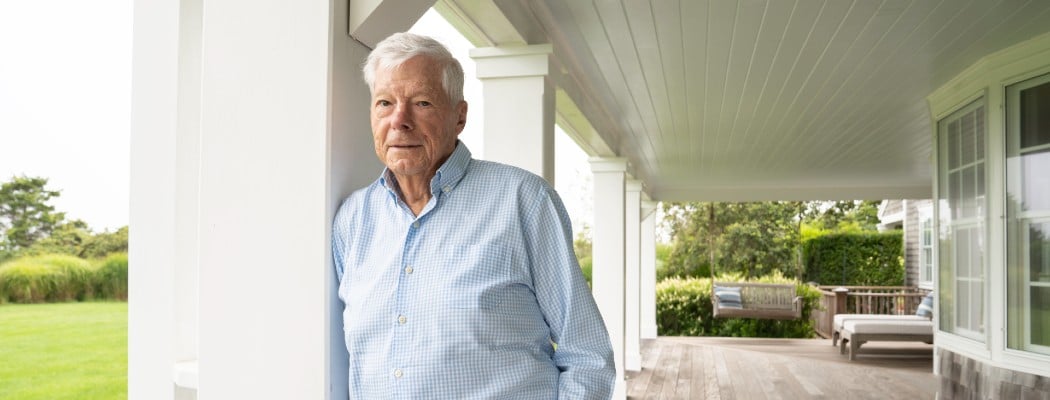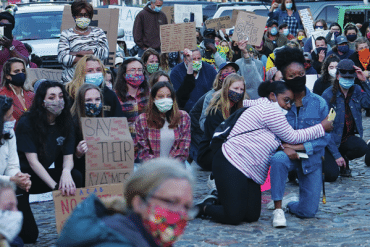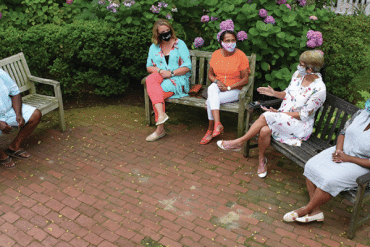The man who reshaped modern Boston.
At ninety-four years old, there’s no question that Jerry Rappaport has lived a full life. Yet, as Abraham Lincoln would have noted, what’s most remarkable is not the years in Rappaport’s life, but the life in his years. A Harvard-educated lawyer turned developer turned philanthropist, Rappaport can trace his impact back to prestigious institutions, prominent political figures and entire city blocks in Boston that still bear his fingerprints. Today, he and his wife Phyllis are championing both cutting-edge medical research as well as the next generation of American leaders. This longtime Nantucket homeowner has achieved a lot during his nine decades of life by not wasting any time—starting from the very beginning.
 A child of soaring intellect, Rappaport was a troublemaker in elementary school until a teacher discovered that he simply needed his energy channeled into more challenging subject matter. She turned him on to studying Latin America and by the fourth grade he was the foremost expert on the topic in the Bronx public school system. By the sixth grade, after his father moved the family to Manhattan, Rappaport was actually giving lectures on Latin America to the rest of the student body at the behest of his teachers. Outside of the classroom, the eleven-year-old competed in Kid Wizards, a New York City-wide radio show where he dominated questions on science, history and geography. It wouldn’t be the last time his voice was heard over the airwaves.
A child of soaring intellect, Rappaport was a troublemaker in elementary school until a teacher discovered that he simply needed his energy channeled into more challenging subject matter. She turned him on to studying Latin America and by the fourth grade he was the foremost expert on the topic in the Bronx public school system. By the sixth grade, after his father moved the family to Manhattan, Rappaport was actually giving lectures on Latin America to the rest of the student body at the behest of his teachers. Outside of the classroom, the eleven-year-old competed in Kid Wizards, a New York City-wide radio show where he dominated questions on science, history and geography. It wouldn’t be the last time his voice was heard over the airwaves.
Rappaport proceeded to hopscotch through high school, skipping grades until the age of sixteen when he applied and was accepted to Harvard. “I was the first student from the Taft School to even think about going to Harvard,” Rappaport said. “I chose Harvard because FDR had gone there and he had been my folk hero.” He completed his first three years of Harvard in just sixteen months and entered Harvard Law School. “I was filled with this passion about the world changing and the responsibility at the end of World War II of creating a better society,” said Rappaport, who, due to the fact that he was one of the youngest students at Harvard Law, was assigned the dean as his advisor. “Law school graduates became important in public affairs and elected office, but they were living in a monastery, a trade school, a vacuum. They needed to be exposed to the problems that were going to impact our world while we were at the law school.”

To expose his fellow students to real-world issues, Rappaport created the Harvard Law School Forum. Inspired by town hall forums he’d heard broadcasted over the radio, he asked the dean if he could start a forum where prominent government officials and academics would discuss the issues of the time. Approving of the idea, the dean gave him an office, a phone and a letter of introduction to Supreme Court Justice Felix Frankfurter—a former professor of Harvard Law—who would help him enlist speakers from Washington. With five hundred to eight hundred people in attendance, the Harvard Law School Forum was broadcasted statewide over the radio and became the longest running law school speaker series in the country, featuring figures such as John F. Kennedy, Fidel Castro and Martin Luther King Jr. over the years.

Graduating Harvard Law at the age of twenty-one, Rappaport was enlisted by Boston mayoral hopeful John Hynes to help run his campaign against James Michael Curley, the hugely controversial four-term mayor whom Hynes had briefly replaced while he was serving a jail sentence for mail fraud. “The campaign manager really allowed me to be at the center of everything in the political process,” Rappaport said. “I brought a whole new vision to the campaign.” He believed that victory could be secured for Hynes—whom many deemed a long shot—by rallying young voters behind the candidate. Though some political strategists within the campaign initially pooh-poohed the idea, Rappaport succeeded in dramatically galvanizing the youth vote, which publications from The New York Times to Reader’s Digest lauded for Hynes’ stunning win against Curley in 1949. As the Coronet wrote in 1953, “Rappaport had molded in one year the most active political organization the city had ever seen.” Defeating Curley propelled Rappaport to political prominence, not just in Boston but across the country.
After the election, Rappaport became one of Hynes’ chief assistants in the mayor’s office and was appointed to a three-man committee tasked with reorganizing and restructuring city government. Central to that mission was the creation of a planning department that developed a master plan of the city. Back in the early 1950s, Boston wasn’t the bustling metropolis it is today. “The population was diminishing by a hundred thousand,” Rappaport described. “People and retail stores were moving to the suburbs. Textile, shoe and leather manufacturing went south. The city hadn’t had a new building built in twenty-five years, except maybe the old John Hancock. This was all against the background that there was no vision, no plan.”

As the Hynes administration tried to introduce reforms to the city, members of the old guard on the city council, some of whom were Curley loyalists, resisted and threw up roadblocks. Rappaport realized that reform would only come if a larger cross-section of the population was engaged in city government. Working outside of the mayor’s office, he turned to the army of young people he’d organized behind Hynes to form the New Boston Committee, a broad-based citizens organization that would represent all twenty-two wards. Within the committee, he created a civic council consisting of leaders from each ward that were recruited by his young allies. The New Boston Committee became a mighty political force that helped elect five out of the nine city council members and four out of the five school committee seats in 1951. At just twenty- four years old, Rappaport had effectively altered the face of city government. This did not go unnoticed. A year after John F. Kennedy was awarded the prize, Rappaport was named Massachusetts’ Most Outstanding Young Leader.

Despite his growing political powers, Rappaport wasn’t long for city government. “Early on, John Hynes told me not to enter government on the basis of becoming a perpetual occupant of political office because you become restricted, you become fearful, you become a civil servant, you lose your vision, you lose your freedom,” Rappaport said. So, after three years, he left city government and started his own law firm that would transform the city of Boston in other ways. “I really thought that it was easier to change Boston physically than change it politically,” he said. “I recognized early on that zoning in Boston was antiquated and needed to change.” Representing developers, Rappaport literally brought the city to new heights by achieving the first height variations in Boston, which would give rise to new fifteen-story towers in historic neighborhoods like the Back Bay.
However, Rappaport’s most history-making development came with Boston’s West End. In the 1950s, the federal government was promoting urban renewal in cities across the country by pledging to subsidize an approved list of major projects through the Housing Act of 1949. Boston had three such projects identified by the planning department, one of which was forty-four acres known as the West End. “The West End area had been considered for redevelopment back for forty years because it was considered to be a slum,” Rappaport said. “That doesn’t define the people who lived there; it defines the area. The statistics showed that it had narrow streets, four-story walk-up units.” Thirty percent of the apartments were abandoned, while 80 percent of the buildings were deemed sub-standard. The streets were tight and tangled. There was not high demand for the project. Rappaport joined forces with two others in bidding for the project, which had been approved for 2,400 apartments and commercial areas. Paying between $40,000 and $50,000 per acre, they won the bid, thus beginning a sixteen-year saga that would change Boston forever.

“Every newspaper in the city supported the West End project,” Rappaport said. “The church supported it, the unions supported it, the Chamber of Commerce supported it. It was considered the great hope for the city.” Seeking to lure people back from the suburbs, Rappaport hired first-class architects to create new luxury high-rises. They eliminated streets to make the neighborhood more walkable, from the Charles River straight through to the other end of town. After completing the first section of apartments, they put up a sign reading: “If you lived here, you’d be home now.” People got the message.

“Charles River Park [as the development became known] is probably one of the most successful in achieving what was visualized as the goals for the city,” Rappaport said. “It brought back 7,500 people. It created a new tax base. It was the first redevelopment project in the whole city. It was the first residential building. It was a first hotel built in years. The first urban Stop & Shop. It built the first urban movie theater since the 1930s.”
But not everybody welcomed the change. The development required the relocation of working-class families who lived in the West End. The sweeping demolition of decrepit public housing buildings resulted in the displacement of 4,700 families who were told they would eventually be able to return to the neighborhood—but few did. “I think that many of the people of the West End have a legitimate complaint about the way the policy was administered,” Rappaport said. “There was an insensitivity to the relocation of both commercial tenants and low-income tenants. There was a sense of community that could have been handled better. But you have to understand that there wasn’t any experience with relocation at this size or scale. And it was all the government…we had nothing to do with it. We were the developers.” In the years following the West End development, Rappaport represented other property owners and tenants as a lawyer to change how the law was administered in similar projects.
While other developments dotted Rappaport’s career, none reached the stature of Charles River Park. Instead, his future crowning achievements came in the forms of family and philanthropy. He raised ten children and put them all through college and multiple graduate schools. When the last child left the nest, Rappaport turned his time and treasure toward fighting Alzheimer’s disease, which had claimed his mother’s life. “That was a disastrous disease, which was incomprehensible at the time because the body existed, but the person wasn’t there,” he said. “I was very impacted by it and I didn’t have a lot of money, but I wanted to do something about it.” With the help of his wife Phyllis, Rappaport established a modest $100,000 grant at Harvard Medical School to support graduates who wanted to pursue Alzheimer’s research. Today, the Rappaports are key drivers behind the Cure Alzheimer’s Fund, which has awarded more than $125 million in research grants since 2004.

In the early 1980s, Rappaport endowed Harvard’s Kennedy School of Government to set up a fellowship designed for elected city and state officials from the city of Boston to attend a master’s program. The fellowship reflected Rappaport’s longtime mission of connecting academics with politicians, believing that both parties had much to learn from one another. “Politicians could know more about theory, and the academics could know how to put solutions into effect,” Rappaport explained. “This wasn’t just about educating politicians; I wanted the students to learn the skills the politicians had to implement ideas.” The fellowship has been in existence for thirty-five years, expanding to include appointed public officials as well as those elected, and has improved the relationship between Harvard and the city governments of Boston and Cambridge.
After he began selling his holdings of Charles River Park in the nineties, Rappaport accumulated some wealth. “I never believed in having trustee kids, so I thought I would set up a foundation,” Rappaport said. He and Phyllis established the Rappaport Foundation in 1997, which was designed to promote emerging leaders in public policy, science and the arts. Through the Rappaport Institute at the Kennedy School of Government and the Rappaport Center for Law and Public Policy at Boston College Law School, they’ve supported more than 550 public policy fellows who have gone on to make tremendous impacts while holding prestigious positions in government.

Meanwhile, their partnerships with Massachusetts General Hospital, McLean Hospital and Brigham and Women’s Hospital have empowered more than seventy research fellows in addressing some of the most confounding afflictions to mental health. And the Rappaports show no signs of slowing down. Earlier this summer, McLean Hospital announced the Phyllis and Jerome Lyle Rappaport Center of Excellence in Basic Neuroscience Research, which represented a doubling down on their decades-long support of emerging leaders who are seeking cures for schizophrenia, bipolar disorder, depression and other mental illnesses.
Building a lasting legacy usually takes a lifetime, but Jerry Rappaport still believes it was worth getting started early. “You don’t have to grow old to have an influence,” he said. Whether it’s the Harvard Law School Forum that continues to this day, the West End that remains one of the best residential communities in the city, the leaders emerging from his fellowships or the revolutionary science he and his wife are making possible, Rappaport is a testament to what one can achieve during their time on earth. Yet when asked what his greatest accomplishment is, he points to his wife Phyllis and then to the portraits of his large family hanging throughout their home in Sconset.







